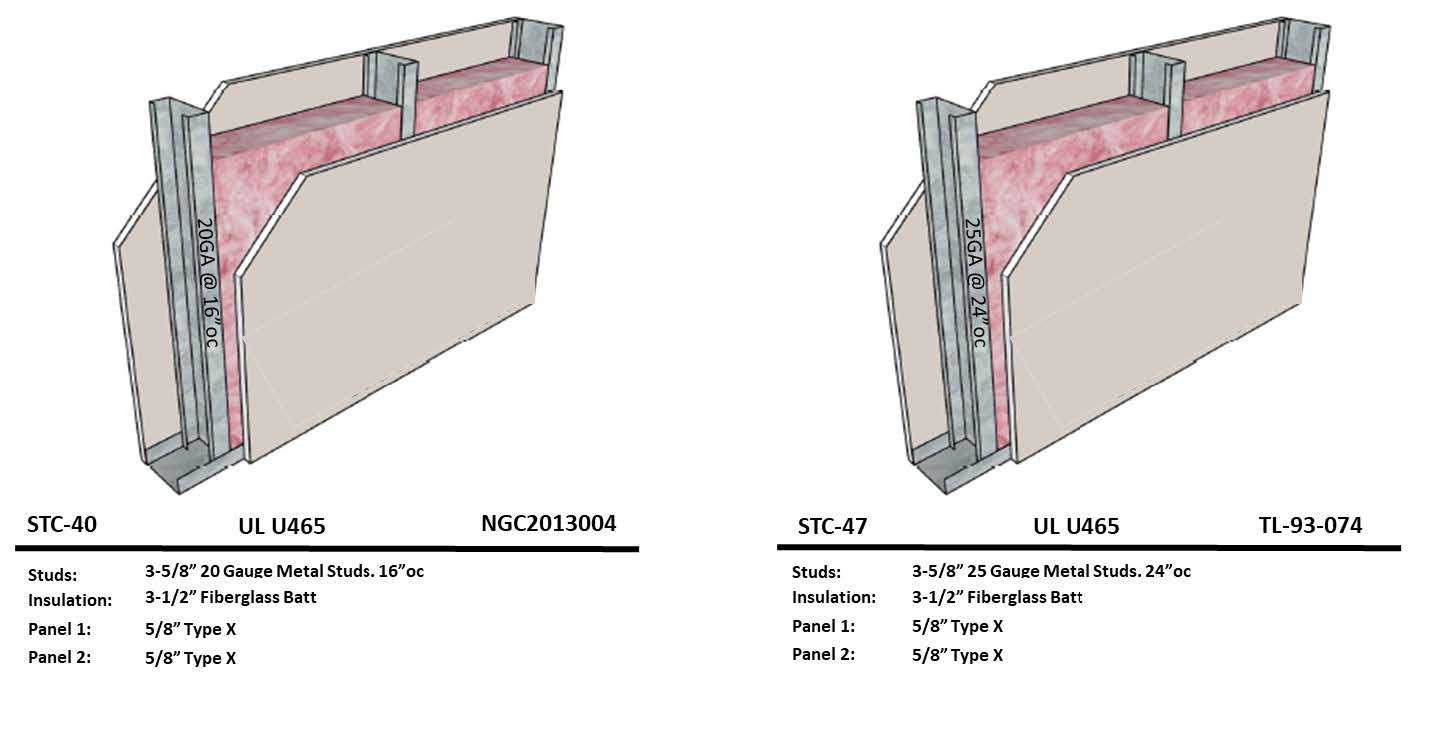Soundproofing Walls – Increase STC, Decrease Cost
You lose 7 STC points by moving from 25‐gauge studs at 24” on center to 20-gauge studs at 16” on center. This cannot be emphasized enough – the number one factor in the soundproofing capacity of a wall is the studs, and not the drywall. The notion of a “thin wall” is antiquated. The drywall is thick enough by itself, but if the stiffness of the wall is too great, then the sound can travel directly through the studs themselves. We will address different STC rules of thumb below.
How Sound Travels Through a Wall

See a simple scenario where a speaker is placed on the left‐hand side (source side) of a single wood-‐stud wall. Sound from the vibrating speaker emanates and becomes airborne. This sound travels to nearby surfaces, and either:
- Transmits through them, reflects off of them, or is absorbed by them.
- The sound that transmits through the nearby drywall layer enters into the cavity, where some is absorbed by the batting and the rest strikes the far layer of drywall, where it undergoes the same 3‐part reaction: absorb, reflect, transmit.
- The sound that is absorbed by the wall or reflected off of it causes the wall to vibrate, creating a structure-‐borne sound. This sound then travels to the nearest stud and transmits through the wall structurally, or it emanates off the drywall into the cavity.
This analysis of the sound pathways provides the basis on which we can make a number of conclusions and apply rules of thumb for STC gain/loss:
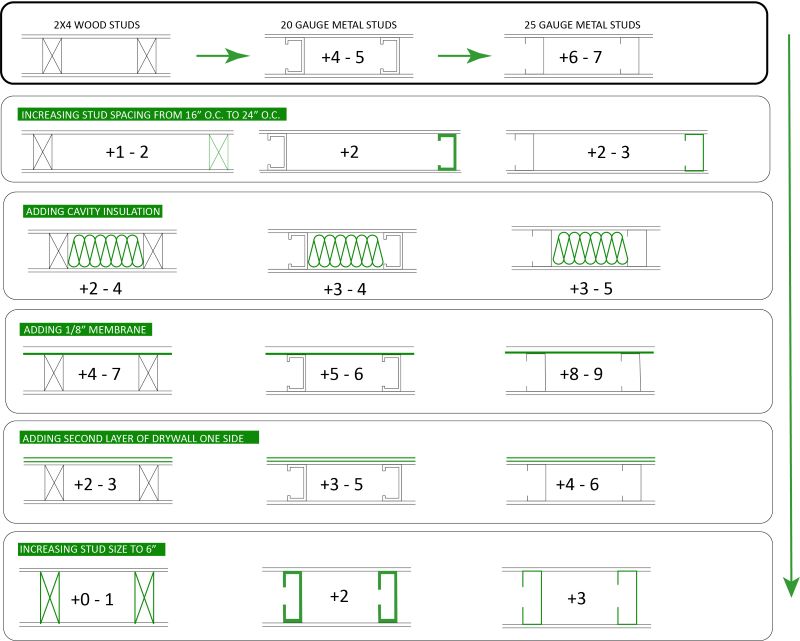
Building Soundproof Walls – Increase STC Ratings
- By moving to a thinner stud, you are reducing the cross-section area available for sound to travel through the stud. Meanwhile, the more ductile (lighter gauge) stud adds more damping to the wall. This change has the added benefit of reducing cost.
- Spreading the studs further apart increases the distance sound must travel to reach the nearest structure‐borne bridge across the cavity.
- Adding batt insulation adds absorption into the cavity for the sound emanating from the source‐side drywall, and also adds damping to the wall.
- Adding a soundproofing membrane behind the source‐side drywall adds significant dense mass to reduce the amount of sound transmitting through the drywall layer, while also adding a resilient layer between the drywall‐to‐stud connection, reducing the structure‐borne transmission.
- Adding layers of gypsum will reduce the amount of airborne sound that transmits directly through the source‐side drywall. However, the sound that has already reflected/absorbed and is traveling via structure-‐borne transmission is unaffected.
- Doubling stud size increases the distance that sound must travel through the stud. This helps much more with the soft, ductile steel of 25‐gauge than it does with a rigid 2×6 stud.
- Resilient channel breaks the structure‐borne path between drywall and stud. However, this path may be grounded (“short-‐circuited”) in any number of ways (See Our Common Soundproofing Mistakes).
- Adding Acoustically-‐Enhanced Drywall adds mass to reduce the airborne sound transmitted through the layers, while its interior visco‐elastic layer also adds a gelatinous layer through which the structure-‐borne sound is decoupled.
2×6 stud walls block no more sound than 2×4 stud walls. However, moving to 25-‐gauge studs at 24” on center greatly improves the STC of the partition.
STC Rating Improvements & Coast Savings

- Reducing stud gauge and moving to 24” on center studs reduces the overall cost.
- Note on costs: we’ve used an approximate, installed cost per square foot. These are dependent on a number of variables. For instance, cost/sf of drywall can be as low as $1/sf for hung ½” drywall, or $8/sf for hang, tape, mud, and texture 5/8” type X drywall with union labor. Costing was derived using RS Means 2019 and coordinating with a number of drywall installation contractors from Florida to New York. Nominal costs based on 10,000 square foot commercial job with wall heights of 10’, with on average 1 penetration (outlet, junction box) per board of Sheetrock. Please verify costs with a licensed contractor in your area.
Mass & Decoupling
Mass Law: rule stating that the sound insulation of a single whole is determined by its weight per unit area; doubling the weight of the partition increases the STC by 5 dBA. Put another way – The amount of sound passing through a medium is inversely proportional to the mass of that medium.
This works to an extent. See chart below displaying the “diminishing returns” of simply adding mass to a partition. Adding mass only “counts” if it across the entire partition, such as adding a layer of drywall or thickness to a concrete wall. Simply doubling the amount of studs (two-‐packs) does not add mass across the wall, and therefore, does not improve the STC.
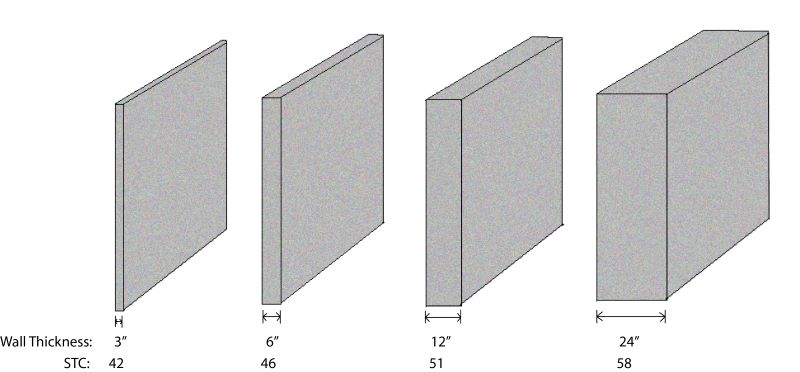
Decoupling: the soundproofing of the wall is improved by adding flexible connection through which the structure-borne sound must travel, which serves to dampen the sound. Common decoupling methods include: staggered studs, double studs, and resilient channel. In rigid assemblies, these can be much more effective than simply adding mass.
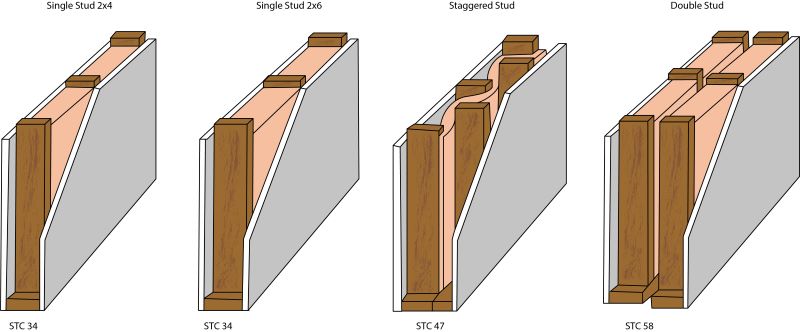
Note here how critical it is to add decoupling into a wall with wood studs. Wood studs have a 2” cross‐section, unlike the much smaller cross‐section of a metal stud wall. They are also much stiffer; while you can bend 25-gauge metal with your bare hands, wood studs are much too rigid to bend. Use of wood studs results in a significant amount of sound that travels directly through the studs into adjoining piece of drywall and into the adjacent space.
CMU STC Rating
While CMU has high-mass per square foot compared to wood and metal‐stud assemblies, its STC performance is often not appreciably higher. This is because, while heavy, the CMU blocks have a significant cross‐section for structure‐borne propagation.
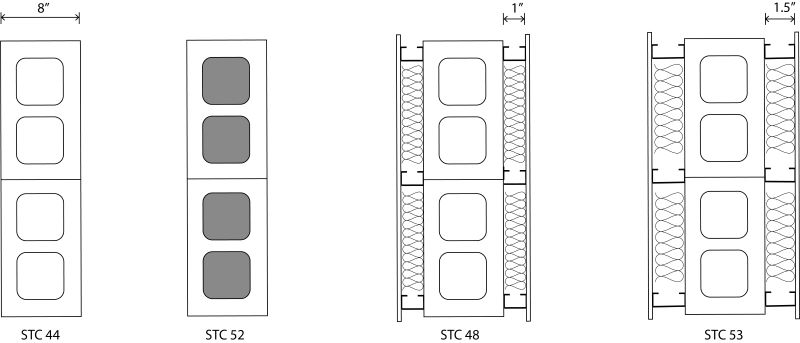
To improve the STC of CMU walls, one of two approaches should be taken:
- Fill the cavities in the CMU. While the CMU has high‐weight, it is not evenly distributed, since the large voids are separated by only the (relatively) thin walls of the cinder block. Filling the cavities should be done with sand or grout.
- NOTE: Filing every fourth cavity with rebar and grout does not contribute to STC. To gain STC points by filling the cavities, 100% of the voids must be filled.
- Add wide furring strips on the wall: By adding 25 gauge studs on the CMU wall, with a depth of 1.5”‐2”, the structural path through the wall is greatly decoupled. This approach is much more effective than adding numerous layers of drywall, since the effectiveness of the mass of the wall is already limited by its rigidity.
STC Rules of Thumb for Your Walls
If you only keep one thing in mind from this article it should be the fact that stronger walls do NOT block more sound. Instead, stiffer walls transmit more sound, while more flexible walls block more sound.
Once a wall assembly is picked, be sure to incorporate acoustic details into your project. Acoustic details help to ensure all materials are installed in a way that will help ensure field STC ratings match lab test STC ratings. Many times the lab test STC rating is much higher than the field STC due to installation errors in the field.
Contact Commercial Acoustics if you are considering options for your wall assembly, to improve your STC ratings while reducing cost and wall thickness.

